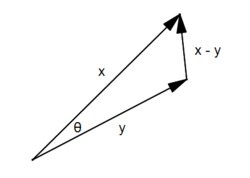

 |  |
We also define the norm of a vector $x$, denoted by $||x||$, by
$$||x|| = \sqrt{x_1^2 + x_2^2 + \cdots + x_n^2}$$
This is meant to be geometrically interpreted as the length of the vector, or equivalently, the distance between the points $(0,0,...,0)$ and $(x_1,x_2,...,x_n)$.
Interestingly, we note that this can be written in a much shorter way by invoking the dot product:
$$||x|| = \sqrt{x \cdot x}$$
Now, armed with the ideas of the dot product and the norm of a vector, suppose we are interested in finding the angle between two given vectors, $x$ and $y$.
Recall that the Law of Cosines, a generalization on the Pythagorean Theorem, gives us the relationship between the side lengths of an arbitrary triangle. Specifically, if a triangle has side lengths $a$, $b$, and $c$, then
$$a^2 + b^2 - 2ab\cos \theta = c^2$$
where $\theta$ is the angle between the sides of length $a$ and $b$.
Consider the triangle that can be formed from the vectors $x$, $y$, and $x-y$.

Applying the Law of Cosines to this triangle, we have
$$||x||^2 +||y||^2 - 2||x|| \, ||y||\cos \theta = ||x-y||^2$$
But this implies, using our observations about the dot product made above, that
$$\begin{array}{rcl}
(x \cdot x) + (y \cdot y) - 2||x|| \, ||y||\cos \theta & = & (x-y) \cdot (x-y)\\
& = & x \cdot (x-y) - y \cdot (x-y)\\
& = & (x \cdot x) - (x \cdot y) - (y \cdot x) + (y \cdot y)\\
& = & (x \cdot x) - (x \cdot y) - (x \cdot y) + (y \cdot y)\\
& = & (x \cdot x) - 2(x \cdot y) + (y \cdot y)\\
\end{array}$$
Subtracting the common $(x \cdot x)$ and $(y \cdot y)$ from both sides, we find
$$- 2||x|| \, ||y||\cos \theta = - 2(x \cdot y)$$
Which, solving for $\cos \theta$ tells us
$$\cos \theta = \frac{x \cdot y}{||x|| \, ||y||}$$